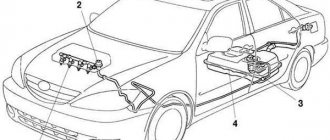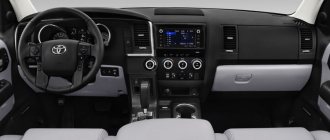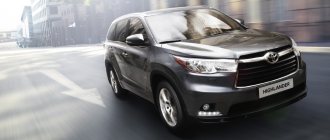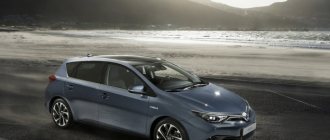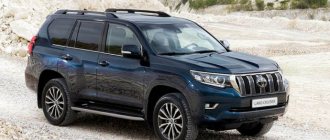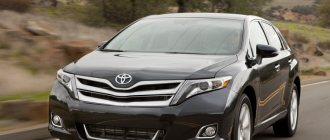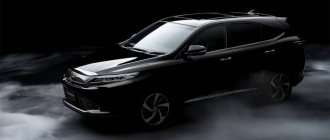The Toyota Camry Solara began selling in 1998. First, a convertible appeared, and a couple of months later, a coupe. The car was designed based on the Camry XV20. Solara, like her older sister, was created for the American market and had qualities that are valued overseas.
Camry Solara convertible first generation
Modifications of Toyota Camry coupe
Camry XV20 and Solara
The first generation of Solara appeared in 1998. The Toyota coupe and convertible differed from the Camry XV20 in their bright, aggressive design and slightly more powerful engines. The exterior of the Solara has more chrome, which is practically absent from the appearance of the sedan of those years.
Only gasoline engines were installed: a four-cylinder 2.2 with the index 5S-FE developed 133 (XV20) and 135 (Solar) horsepower, V6 V6 3.0 with the marking 1MZ-FE - 194,200 horsepower, respectively.
Restyling, which took place in 2001, transformed the front of the car. The design of the headlights, radiator grille and bumper has changed. The technical part has also undergone changes; a new 2.4 engine has appeared, the same 2AZ-FE, producing 157 hp in the coupe and convertible. and 220 N*m of torque.
Solara XV20 before and after restyling
The second generation Camry Solara began selling in 2003, it was designed on the basis of the Camry XV30. The Camry coupe and convertible versions were equipped with 2.4 2AZ and 3.3 3MZ engines with 157 and 225 horsepower, respectively. On the sedan, the V6 engine was 3 liters and developed only 186 hp.
Toyota Solara XV30 restyling
The restyling of the second generation, which happened in 2006, did not change the car significantly. A noticeable change in appearance was the new bumper, and the steering wheel and dashboard were changed in the interior. In technical terms, the main innovation was a five-speed automatic transmission for the 3.3 engine.
Car design
The differences between the 7th generation Camry and its predecessors are immediately obvious. First of all, the body design has undergone innovations. The updated panels and overall design moved away from the smooth lines of its predecessors and set a new corporate standard. In addition, over the past few years, the Toyota Camry VII has undergone several major changes. The overall appearance is currently designated as a mixture of aggression with scale and expression.
The front end is flanked by a massive grille lip with a wide honeycomb and a large space between the chrome strips (owners may want to install a mesh in this area for additional radiator protection). The massive headlight unit with the option of installing xenon lights creates an impressive front end.
The side of the Toyota Camry VII has practically no protruding edges, except that the doors are highlighted with stamping in the lower part. The rear part is also highlighted by a massive lighting unit.
In the new generation, all models are equipped with LED lighting (economical, reliable and stylish). The overall appearance, moving away from smooth lines, acquired rigor, and it was this factor that became decisive (at least in the domestic market) for making the seventh model the undisputed market leader.
Even during a crisis, when sales of the vast majority of manufacturers are steadily declining, Toyota Camry VII does not give up its position and sells about 20,000 cars annually, when its closest competitors are content with half as many.
Technical characteristics of Solara
The second generation of Toyota coupe is designed on the basis of the Camry XV30, so many of their technical characteristics will be similar. For example, the same wheelbase is 2720 mm, the same fuel tank volume is 70 l. The 2.4-liter power unit was the same for the two 2AZ-FE models, but it produced different power indicators. In Solar, the engine produced 157 hp. and 220 N*m at 4000 rpm, in the XV30 – 152 hp. and 218 N*m at 4200.
Characteristics of the 3.3 3MZ-FE engine: power - 225 horsepower, 325 Nm torque at 3600 rpm.
Not surprisingly, the trunk volume of the coupe was significantly less: 391 for the Solara, more than 500 for the XV30. Body dimensions vary: length - 4890 for the coupe and convertible and 4815 for the sedan, width 1816 and 1795, height 1425 and 1500 (measurements in mm).
Solara XV30 engine 2.4
Fuel consumption Solara with 2.4 2AZ-FE engine
- 5 manual transmission – 9.8 l in the city, 7.1 l outside the city
- 4 automatic transmission – 10.2 l in the city, 7.4 l outside the city
Fuel consumption of Solara with 3.3 3MZ-FE engine
- 5-speed manual – 9.8 in the city, 7.1 outside the city
- “Automatic” with 4 speeds – 10.2 in the city cycle, 7.4 on the highway
- Five-speed automatic – 11.2 in the city, 8.1 on the highway.
The Camry Solara was equipped with 215\60R16 and 215\55R17 wheels from the factory.
Interior decoration of the model
Changes in the new Toyota Camry VII have also occurred in the interior space. Due to a slight increase in the wheelbase, the space for rear passengers has increased both in length and width. Naturally, with such dimensions, 3 adult passengers can fit in the back. Of course, in this case there is no need to talk about high comfort, but driving short distances is quite acceptable.
The designers did not shy away from the controversial decision: on the “top” trim levels, the center console and door panels are still trimmed with wood-like plastic. It was this detail that caused the most negative exclamations, since many considered it pretentious, and besides, “crickets” in the cabin often appeared there.
The car received a new information panel - all instruments are readable very clearly and clearly, there is no glare in the sun. Also, the Toyota Camry VII has a new media complex (depending on the configuration, equipped with a rear view camera and 6 or 8 speakers).
Other seat finishing materials provided greater comfort for the driver and passengers. This was also largely due to the improved sound insulation of the cabin.
Photo of Camry Solara XV30
Solara XV30 convertible and coupe
Solara XV30 salon after restyling
Solara coupe
Red cool convertible
Solara 2004 rear view
Technical side
In terms of engines for our market, practically nothing has changed. A two-liter engine was added to the range of power units (a tribute to the crisis and savings). When driving, the car has become softer (the main goal when developing the model was for the North American market, where they like excessive rolliness).
Thanks to the optimal suspension settings for our market, the car handles potholes quite confidently, but turns into corners with quite a lot of roll.
About engines of Toyota Camry 7th generation XV50 (2011 - present)
Toyota Camry is a representative of cars belonging to the middle, partly business class. In the Toyota lineup, the Camry occupies a place between the Avensis/Corolla and the Avalon business sedan. The Camry is based on the common Toyota K platform, which is the base for cars such as Avalon, Highlander, Sienna, Venza. Camry's competitors are: Hyundai Sonata, Kia Optima, Ford Mondeo, Opel Insignia, Nissan Teana/Maxima/Altima, Mazda 6, Honda Accord, Volkswagen Passat, Subaru Legacy. Camry engines correspond to the dimensions of the car and have a displacement from 2 to 3.5 liters. We will talk about the characteristics of these engines, the oil and fuel used in them, common faults and how to fix them.
ENGINE TOYOTA 1AZ-FE/FSE 2.0 L.
The AZ series was developed in 2000. It was created to replace the popular and in-demand S family. The new engines had a lightweight cylinder block made of light aluminum, and there was a VVTi variable valve timing system on the intake shaft. The presence of direct fuel injection, in order to reduce the load on the liners, an offset of the cylinder axis relative to the crankshaft axis is used. An electronic throttle valve is used. The 1AZ-FE/FSE engine is the successor to the 3S-FE/FSE, but the latter has more modifications. The Toyota 1AZ engine has the following modifications.
- 1AZ-FE base engine, with a compression ratio of 9.6 and 9.8. With a power of 145 and 150 hp. Produced since 2000.
- 1AZ-FSE (D4) is essentially similar to 1AZ-FE, but has direct fuel injection. Engine with compression ratio, 9.8, 10.5 and 11 based on modification. With engine power from 150 to 155 hp.
If we talk about 1AZ malfunctions, we can name the following.
- The thread on the cylinder head attachment block breaks. A common problem with most AZ engines. It is corrected by restoring the threads, or replacing the cylinder block with a new one, produced since 2007.
- Engine vibrations. They appear mainly with a drop to 500-600 rpm. This is not a malfunction, but a specific feature of the engine. Cleaning the idle air valve, throttle valve, injectors, EGR system, and checking the airbag can help reduce the symptoms.
- Jerking 1AZ engine. Cleaning the throttle body and carbon deposits on the intake manifold and flaps will probably correct the situation.
In addition, if such an engine overheats, loss of geometry may occur, which will ultimately lead to the need to replace the engine with a contract version. FSE (D4) variants are quite sensitive in relation to fuel; filling with low quality fuel can damage the fuel injection pump and injectors. Meanwhile, the timing chain is good and can withstand 200 thousand km. The block is disposable, but the engine has a good service life, up to 300 thousand km. The engine is reliable if properly maintained. Based on it, he developed a larger volume unit, 2AZ 2.4 liters.
TUNING OPPORTUNITIES
There are ways to convert the engine to 2.4 liters. 2AZ, however, such options are a bit expensive. More affordable ways to increase power are the use of supercharging. For AZ engines, manufacturers Blitz and TRD produced kit compressor options. You need to buy and install such a kit, and also add an intercooler, blowoff, thick cylinder head gasket, 440cc injectors, and a Walbro 255 lph pump. Then we remove the catalyst, or replace the exhaust with a direct-flow exhaust with a diameter of 63 mm. Then we set up Greddy E-manage Ultimate and squeeze out 200 hp.
ENGINE TOYOTA 2AR-FE/FSE/FXE
The 2AR-FE engine began coming out in 2008 to replace the 2AZ-FE with a 2.4 liter. The engine has an aluminum cylinder block and thin cast iron liners. The crankshaft has 8 counterweights, it is installed by shifting it by 10 mm in the exhaust direction. The crankshaft drives a pair of balancer shafts. The pistons have been lightened and it has a floating pin. A three-layer metal gasket is used to install a double-shaft aluminum cylinder head and hydraulic compensators. It has a system of variable valve timing on Dual-VVTi camshafts. Phase adjustment 50 degrees for intake, 40 degrees for exhaust. The camshafts are driven by a single row timing chain. There was a 2AR-FSE version, which had different pistons (with 13 compression), as well as an excellent cylinder head, direct injection of D4-S fuel, and fresh camshafts. For Toyota and Lexus hybrids, they produced the 2AR-FXE engine, operating according to the Atkinson cycle, equipped with different pistons (compression 12.5). Based on the 2AR, they make the more serious 1AR-FE 2.7 liter. The engines are good, there are no significant complaints about their performance. But there are minor ones, such as: leaking pumps, knocking of the VVTi clutch. It is not expected that the engine can be repaired. However, the engine, subject to high-quality care and maintenance, is distinguished by reliability and quality of work.
TUNING OPPORTUNITIES
To carry out significant tuning, you will need to invest a lot of money. A reasonable option would be to purchase a turbo kit for 2AR-FE based on the Garrett T3/T04E. They are placed under the stock piston and do not involve lowering the compression ratio. We also add a 63 mm exhaust. The presence of a boost of 0.7 bar allows you to achieve 320 hp. The stock piston can withstand 350 hp, but if it’s over 400 hp. then it’s worth purchasing forged ones. However, all this comes at a rather high cost.
ENGINE 2GR-FE/FSE/FXE/FZE
The 2GR engine was developed in 2005 to replace the 3MZ-FE, based on the 1GR 4 liter. The piston stroke was reduced to 83 mm. The engine's cylinder block is made of aluminum, liners are made of cast iron, the cylinder camber is 60 degrees, the piston is light, the connecting rods are forged. The timing belt is on a chain, with hydraulic compensators, there is no need to adjust the valves, it is equipped with a variable valve timing system for the Dual-VVTi intake and exhaust shafts. The engine also has modifications.
- 2GR-FE main engine, compression 10.8, has a power of 277 hp.
- 2GR-FSE (D4S) is similar to 2GR-FE and has direct fuel injection. Compression 11.8, has a power of 296-318 hp.
- 2GR-FXE is similar to 2GR-FE and functions according to the Atkinson cycle. Compression 12.5 - 13. Has a power of 249-295 hp.
- 2GR-FZE sport version. Installed on Lotus and Toyota Aurion TRD cars.
- 2GR-FKS is a hybrid of 2GR-FXE and 2GR-FSE and has direct fuel injection. Has a power of 278 hp. at 6000 rpm, torque 360 Nm at 4600 rpm. Lexuses with such an engine squeeze out 295-311 hp.
- 2GR-FXS hybrid 2GR-FKS. Has a power of 313 hp. at 6000 rpm, torque 335 Nm at 4600 rpm.
The following faults exist.
- Oil is leaking. On engines before 2010, it is necessary to replace the oil line with an all-metal one.
- Engine noise/crackling during startup. The problem is in the couplings, this is the specificity of the engine. The couplings need to be replaced.
- Low idle speed. The throttle valve needs to be cleaned. And repeat this every 50 thousand km.
TUNING OPPORTUNITIES
There are not many opportunities for high-quality tuning. You can try installing MWR pistons with 12 compression, porting the cylinder head, installing a 3-1 exhaust, but the result will be insignificant. A good option would be to install a supercharger. Similar to 1GR, kit compressors are produced for the engine by TRD and HKS. They are supplemented with Wiseco Piston pistons for SZh 9, 440 cc injectors, this gives a total of 350 hp. To go further, you need to install a powerful supercharger, Apexi Engine Management.
| Production | Kamigo Plant Shimoyama Plant Toyota Motor Manufacturing Alabama Toyota Motor Manufacturing Kentucky Toyota Motor Manufacturing West Virginia | Kamigo Plant Toyota Motor Manufacturing Alabama | Kamigo Plant Shimoyama Plant |
| Engine make | Toyota 2GR | 2AR | 1AZ |
| Years of manufacture | 2005-present day | 2008-present | 2000-present day |
| Cylinder block material | aluminum | aluminum | aluminum |
| Supply system | injector | injector | injector |
| Type | V-shaped | in-line | in-line |
| Number of cylinders | 6 | 4 | 4 |
| Valves per cylinder | 4 | 4 | 4 |
| Piston stroke, mm | 83 | 98 | 86 |
| Cylinder diameter, mm | 94 | 90 | 86 |
| Compression ratio | 10.8 11.8 12.5 13 | 10.4 (2AR-FE) 12.5 (2AR-FSE) 13.0 (2AR-FXE) | 9.6 9.8 10.5 11 |
| Engine capacity, cc | 3456 | 2494 | 1998 |
| Engine power, hp/rpm | 249/6000 270/6200 272/6200 278/6000 278/6200 280/6400 295/6300 309/6400 311/6600 313/6000 315/6400 318/6400 328/6400 350/7000 360/6400 | 154/5700 171/6000 177/6000 181/6000 | 145/6000 150/5700 150/6000 152/6000 |
| Torque, Nm/rpm | 317/4800 336/4700 333/4700 360/4600 346/4700 350/4600 362/4700 377/4800 362/4700 335/4600 377/4800 380/4800 400/4800 400/4500 498/3200 | 187/4400 226/4100 221/4200 232/4100 | 190/4000 193/4000 193/4000 200/4000 |
| Fuel | 95 | 95 | 95 |
| Environmental standards | Euro 5 | Euro 5 | Euro 5 |
| Engine weight, kg | 163 | ~150 | 131 |
| Fuel consumption, l/100 km (for Lexus RX350) - city - highway - mixed. | 14.3 8.4 10.6 | 11.0 5.9 7.8 | 11.4 7.3 9.8 |
| Oil consumption, g/1000 km | up to 1000 | up to 1000 | up to 1000 |
| Engine oil | 5W-30 | 0W-20 0W-30 0W-40 5W-20 5W-30 5W-40 | 0W-20 5W-20 |
| How much oil is in the engine | 6.1 | 4.4 | 4.2 |
| Oil change carried out, km | 10000 (better 5000) | 7000-10000 | 10000 (better 5000) |
| Engine operating temperature, degrees. | — | — | — |
| Engine life, thousand km - according to the plant - in practice | n.d. 300+ | — 300+ | n.d. 300+ |
| Tuning - potential - without loss of resource | 350 n.d. | 300+ n.a. | 200+ n.a. |
| The engine was installed | Toyota Avalon Toyota Camry Toyota Crown Toyota Estima/Previa Toyota RAV4 Toyota Highlander Toyota Sienna Toyota Venza Lexus GS350 Lexus GS450h Lexus IS350 Lexus ES350 Lexus RX350 Lexus RX450h Toyota Alphard Toyota Aurion Toyota Harrier Toyota Mark X Toyota Mark X Zio Lotus Evora Lotus Exige S | Toyota Avalon Toyota Camry Toyota Crown Toyota RAV4 Lexus ES300h Lexus GS300h Lexus IS300h Toyota Alphard Toyota Harrier Lexus NX300h Scion tC | Toyota Avensis Toyota Caldina Toyota Camry Toyota RAV4 Toyota Vista Toyota Premio Toyota Avensis Verso Toyota Noah/Voxy Toyota Gaia Toyota Isis Toyota Wish Toyota Allion Toyota Opa |
